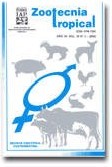
|
Zootecnia Tropical
Instituto Nacional de Investigaciones Agrícolas Venezuela
ISSN: 0798-7269
Vol. 23, No. 3, 2005, pp. 259-294
|
 Bioline Code: zt05018
Bioline Code: zt05018
Full paper language: English
Document type: Research Article
Document available free of charge
|
|
|
Zootecnia Tropical, Vol. 23, No. 3, 2005, pp. 259-294
| es |
Revisión- Metodologías para el estudio de compuestos polifenólicos en especies forrajeras: Un enfoque histórico
Danny E. García y María G. Medina
Resumen
Mediante la revisión de las publicaciones científicas más representativas sobre la bioquímica de los taninos, se presentan los principales resultados relacionados con sus propiedades beneficiosas y antinutricionales a partir de estudios químico-analíticos, in vitro e in vivo. Se tratan los acápites de mayor relevancia y se describe la repercusión de los conocimientos adquiridos sobre estos compuestos, en el desarrollo de estrategias viables de alimentación. Históricamente, hasta que la química de los productos naturales no se desarrolló cuantitativamente, los estudios de nutrición animal con fuentes forrajeras fenólicas fueron incipientes. Los primeros ensayos realizados con posterioridad a 1950 estuvieron encaminados a la caracterización fitoquímica de las fuentes mayoritarias de taninos y la determinación de la actividad biológica de los principales grupos, haciendo énfasis en las leguminosas forrajeras como recurso suplementario por excelencia. En una segunda etapa se implementaron y validaron las técnicas analíticas que se utilizarían para describir el efecto deletéreo de los polifenoles y su interacción con los metabolitos primarios y secundarios. Se postularon las concentraciones críticas en las cuales estos compuestos podían afectar el buen funcionamiento digestivo de los rumiantes y los monogástricos y se comparó la acción detrimental de los taninos condensados e hidrolizables en diferentes condiciones de alimentación, determinando las variables de mayor influencia en su acción toxicológica. Independientemente a que las investigaciones realizadas hasta el presente han aportado mucha información en cuanto a las características de los taninos vegetales, en la actualidad existen temas importantes tales como, los mecanismos relacionados con el efecto antihelmíntico, la función ecológica de los taninos hidrolizables en las especies no leguminosas y la interacción de los polifenoles con los alcaloides, entre otros, que no han sido abordados con fuerza; por lo que se precisan estudios integrales para dilucidar estas apremiantes incógnitas.
Palabras-clave
Polifenoles, taninos condensados, taninos hidrolizables, factores antinutricionales, alimentación animal.
|
| |
| en |
Review- Methodologies for the study of polyphenolic compounds in forage species: A historic review
Danny E. García y María G. Medina
Abstract
By means of the representative scientific publications review on the tannins biochemistry, the main results related to their beneficial and antinutritional properties from chemistry-analytical, in vitro and in vivo studies were presented. The paragraphs are greater relevance and the repercussion of the knowledge acquired on these compounds is described; in the development of viable strategies of feeding. Historically, until the chemistry of natural products was not developed quantitatively, the animal nutrition studies with phenolic forages sources were insufficient. The first tests made after 1950, were directed to the phytochemical characterization of the majority tannin sources and the determination of the biological activity of the main groups, with particular emphasis in fodder leguminous like additional resource of nutrients. In one second stage the analytical techniques were implemented and validated that would be used to describe the polyphenols antifeeding effect and its interaction with the primary and secondary metabolites. The critic concentrations, in which these compounds could affect the good digestive process of ruminants and monogastric were postulated. Besides, the detrimental action of tannins hydrolysables and condensed in different conditions of feeding was compared, determining the variables of greater influence in the toxicological action. Independently to that the investigations made until the present have contributed much information as far as the characteristics of vegetal tannins, at the present time exists important subjects such as, the mechanisms related to the antihelmintic effect, the ecological function of hydrolysables tannins in non leguminous species and the interaction of polyphenols with alkaloids; among others, that have not been boarded with force; reason why integral studies need to explain these urgent questions.
Keywords
Polyphenols, condensed tannins, hydrolysable tannins, antinutritional factors, animal feeding.
|
| |
© Copyright 2005 - Zootecnia Tropical
Alternative site location: http://www.sian.inia.gob.ve/repositorio/revistas_ci/ZootecniaTropical/ztindice.htm
|
|
